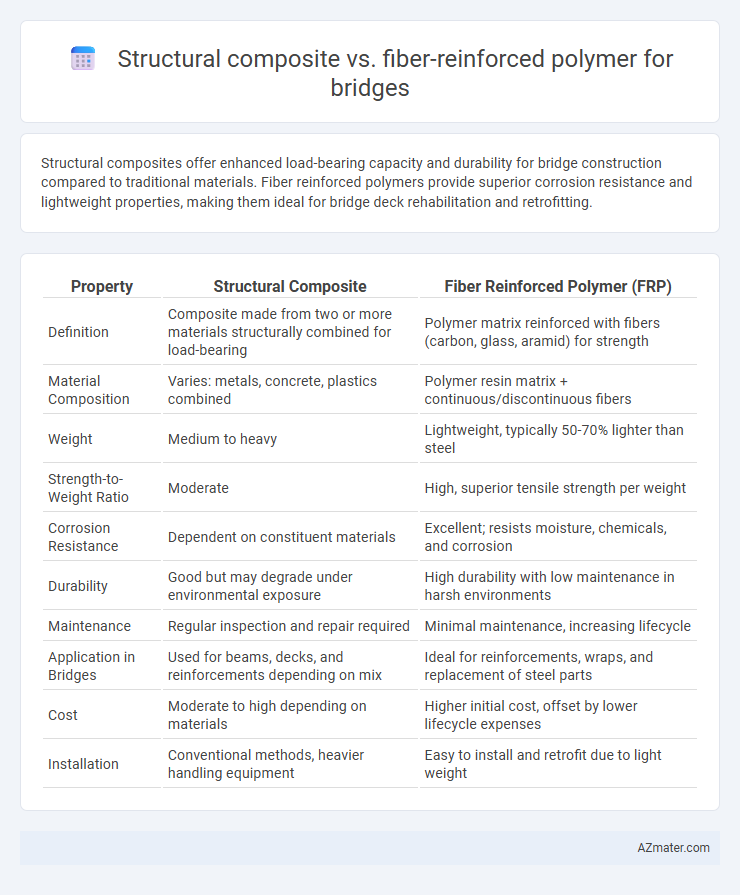Structural composites offer enhanced load-bearing capacity and durability for bridge construction compared to traditional materials. Fiber reinforced polymers provide superior corrosion resistance and lightweight properties, making them ideal for bridge deck rehabilitation and retrofitting.
Table of Comparison
| Property | Structural Composite | Fiber Reinforced Polymer (FRP) |
|---|---|---|
| Definition | Composite made from two or more materials structurally combined for load-bearing | Polymer matrix reinforced with fibers (carbon, glass, aramid) for strength |
| Material Composition | Varies: metals, concrete, plastics combined | Polymer resin matrix + continuous/discontinuous fibers |
| Weight | Medium to heavy | Lightweight, typically 50-70% lighter than steel |
| Strength-to-Weight Ratio | Moderate | High, superior tensile strength per weight |
| Corrosion Resistance | Dependent on constituent materials | Excellent; resists moisture, chemicals, and corrosion |
| Durability | Good but may degrade under environmental exposure | High durability with low maintenance in harsh environments |
| Maintenance | Regular inspection and repair required | Minimal maintenance, increasing lifecycle |
| Application in Bridges | Used for beams, decks, and reinforcements depending on mix | Ideal for reinforcements, wraps, and replacement of steel parts |
| Cost | Moderate to high depending on materials | Higher initial cost, offset by lower lifecycle expenses |
| Installation | Conventional methods, heavier handling equipment | Easy to install and retrofit due to light weight |
Introduction to Modern Bridge Materials
Structural composites and fiber-reinforced polymers (FRPs) represent advanced materials revolutionizing modern bridge construction by offering superior strength-to-weight ratios and enhanced corrosion resistance. Structural composites integrate multiple material phases to achieve high durability and load-bearing capacity, while FRPs utilize continuous fiber reinforcements embedded in polymer matrices to deliver exceptional tensile strength and flexibility. These materials enable longer spans, reduced maintenance costs, and innovative design possibilities essential for sustainable infrastructure development.
Overview of Structural Composites
Structural composites for bridges combine multiple materials to achieve superior strength-to-weight ratios and enhanced durability compared to traditional construction materials. These composites typically consist of fibers embedded in a polymer matrix, providing high resistance to corrosion, fatigue, and environmental degradation. Their customizable properties enable tailored performance for load-bearing and seismic resilience in bridge applications.
Key Properties of Fiber Reinforced Polymers (FRP)
Fiber Reinforced Polymers (FRP) exhibit exceptional strength-to-weight ratios, high corrosion resistance, and excellent fatigue performance, making them ideal for bridge applications. Their low density reduces overall structural weight, while high tensile strength and stiffness enhance load-bearing capacity under dynamic and environmental stresses. FRPs also offer customizable mechanical properties through fiber orientation and resin selection, providing durability and long-term maintenance savings in bridge construction.
Strength and Durability Comparison
Structural composites, including fiber reinforced polymers (FRPs), are widely used in bridge construction for their exceptional strength-to-weight ratio and corrosion resistance. FRPs exhibit superior tensile strength and fatigue resistance compared to traditional materials like steel or concrete, making them ideal for high-load bridge components. In terms of durability, FRPs demonstrate enhanced resistance to environmental degradation such as moisture, chemicals, and UV exposure, leading to longer service life and reduced maintenance costs in bridge applications.
Weight and Structural Efficiency
Structural composites and fiber reinforced polymers (FRPs) offer significant weight reductions compared to traditional steel or concrete in bridge applications, with FRPs typically providing superior strength-to-weight ratios. FRPs exhibit higher tensile strength and corrosion resistance, enhancing structural efficiency by reducing maintenance needs and extending service life. The reduced weight of FRP components lowers dead loads on bridge foundations while maintaining or improving load-bearing capacity, making them highly favorable for long-span and retrofit projects.
Corrosion Resistance and Longevity
Fiber reinforced polymer (FRP) offers superior corrosion resistance compared to traditional structural composites, making it highly suitable for bridge applications exposed to harsh environmental conditions. The non-metallic composition of FRP prevents rust and degradation, significantly extending the longevity of bridge components. This enhanced durability reduces maintenance costs and increases the service life of bridges in marine or chemically aggressive environments.
Installation and Maintenance Considerations
Structural composites offer faster installation times due to prefabrication and lightweight properties, reducing on-site labor and traffic disruptions during bridge construction. Fiber reinforced polymers (FRP) require specialized handling and precise installation techniques to ensure proper bonding and alignment, impacting overall project timelines. Maintenance of structural composites is minimal because of inherent corrosion resistance and durability, whereas FRP components may necessitate regular inspections for fiber degradation and resin integrity to extend service life.
Cost Analysis: Structural Composites vs FRP
Structural composites often present lower initial costs compared to fiber reinforced polymers (FRP) due to simpler manufacturing processes and less expensive raw materials. However, FRP materials provide longer service life and reduced maintenance expenses, leading to lower life-cycle costs in bridge applications. Evaluating total cost of ownership reveals that despite higher upfront investment, FRP's durability and corrosion resistance yield significant savings over time.
Real-World Case Studies
Real-world case studies reveal that structural composites and fiber-reinforced polymers (FRPs) enhance bridge durability and load-bearing capacity, with FRPs often preferred for retrofitting aging infrastructure due to their lightweight and corrosion resistance. The Confederation Bridge in Canada features FRP reinforcements that extend service life while reducing maintenance costs, whereas the Kurilpa Bridge in Australia utilizes structural composites for innovative design and flexibility under dynamic loads. These examples demonstrate the effectiveness of both materials in addressing specific engineering challenges and improving long-term performance in diverse environmental conditions.
Future Trends in Bridge Construction Materials
Structural composites and fiber reinforced polymers (FRP) are revolutionizing bridge construction by offering superior strength-to-weight ratios and enhanced durability against corrosion. Future trends emphasize the integration of smart sensors within these materials for real-time structural health monitoring and predictive maintenance, increasing bridge lifespan and safety. Advances in nanotechnology and bio-based resins are driving eco-friendly and high-performance FRP composites, aligning with sustainable infrastructure goals.

Infographic: Structural composite vs Fiber reinforced polymer for Bridge
 azmater.com
azmater.com